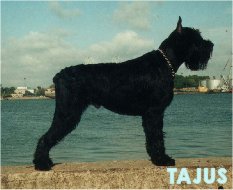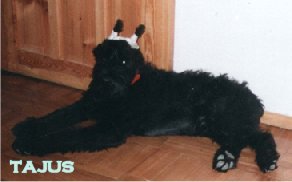Giant Schnauzer standard (FCI) 
TRANSLATION : Mrs. C. Seidler.
ORIGIN : Germany.
DATE OF PUBLICATION OF THE ORIGINAL VALID STANDARD : 06.04.2000.
UTILIZATION : Utility and Companion Dog.
CLASSIFICATION F.C.I. : Group 2 Pinscher and Schnauzer- Molossoid breeds
- Swiss Mountain and Cattle Dogs and otherrr breeds.
Section 1 Pinscher and Schnauzer type.
With working trial.
BRIEF HISTORICAL SUMMARY :
Originally the Giant Schnauzer was used in the region of Southern Germany
to drive cattle. Around the turn of the century, determined breeders realised
that he had outstanding working capabilities and particularly valuable traits
in character. Since 1913 the breed has been registered in a stud book, and
in 1925 already the Giant Schnauzer has officially been recognised as a working
dog.
GENERAL APPEARANCE :
Large, powerful, stocky rather than slim. An enlarged, powerful image of
the Schnauzer. An imperturbable dog, prepared for defense, whose appearance
fills with respect.
IMPORTANT PROPORTIONS :
Square build in which height at the withers is nearly equal to the body length.
The length of the head (measured from the tip of the nose to the occiput)
corresponds to half the length of the topline (measured from the withers
to the set on of the tail).
BEHAVIOUR / TEMPERAMENT :
Typical characteristics of this dog are his good natured, even temperament
and his incorruptible loyalty towards his master. He has highly developed
sense organs, intelligence, trainability, strength, endurance, speed, resistance
to weather and diseases. His inborn ability to bear strain and his self assurance
make him best suited for being a companion, sporting, utility and working
dog.

HEAD
CRANIAL REGION :
Skull : Strong, long without markedly protudring occiput. The head should
be in keeping with the dog’s force. The forehead is flat, without wrinkling
and parallel to the bridge of nose.
Stop : Appears well defined due to the brows.
FACIAL REGION :
Nose : Well developed nose leather with large nostrils, always black.
Muzzle : Ending in a blunt wedge. Bridge of nose straight.
Lips : Black, smooth and tight-fitting to the jaws. Corners of lips closed.
Jaws/Teeth : Strong upper and lower jaw. The complete scissor bite (42 pure
white teeth, according to the dentition fromula), is strongly developed and
firmly closing. The chewing muscles are strongly developed but the cheeks
must not interfere with the rectangular shape of the head (with the beard).
Eyes : Medium sized, oval, facing forward, dark with lively expression. Eyelids
close fitting.
Ears : Drop ears, set high, V-shaped with inner edges lying close to the
cheeks, evenly carried, turned forward towards temples. Folds parallel, should
not be above the top of the skull.
NECK :
The strong, muscular neck is nobly arched, blending smoothly into the withers.
Strongly set on, slim, noble curved, corresponding to the dog’s force.
Throat skin tight-fitting without folds.
BODY
Topline : Slightly sloping from withers towards rear.
Withers : Forming the highest point in topline.
Back : Strong, short and taut.
Loins : Short, strong and deep. The distance from the last rib to the hip
is short to make the dog appear compact.
Croup : Slightly rounded, imperceptibly blending into tail set on.
Chest : Moderately broad, oval in diameter, reaching to the elbows. The forechest
is distinctly marked by the point of the sternum.
Underline / Belly : Flanks not too tucked up, forming a well curved line
with the underside of the ribcage.
TAIL : Natural.
LIMBS
FOREQUARTERS : Seen from the front, the front legs are strong, straight and
not close together. Seen from the side, the forearms are straight.
Shoulders : The shoulder blade lies close against the rib cage and is well
muscled on both sides of shoulder bone, protruding over the points of thoracic
vertebrae. As sloping as possible and well laid back, forming an angle of
appr.50° to the horizontal.
Upper arm : Lying close to the body, strong and well musculed, forming an
angle of 95° to 105° to the shoulder blade.
Elbows: Close fitting, turning neither in nor out.
Forearm : Viewed from all sides completely straight, strongly developed and
well muscled.
Carpal joint : Strong, firm, barely standing out against the structure of
the fore arm.
Pastern : Seen from the front, vertical. Seen from the side, slightly sloping
towards the ground, strong and slightly springy.
Forefeet : Short and round, toes well-knit and arched (cat foot) with short
dark nails and resistant pads.
HINDQUARTERS : Standing obliquely when seen from the side, standing parallel
but not close together when seen from the rear.
Upper thigh : Moderately long, broad and strongly muscled.
Stifle : Turning neither in nor out.
Lower thigh : Long and strong, sinewy, running into a strong hock.
Hocks : Very well angulated, strong, firm, turning neither in nor out.
Metatarsus : Short, vertical to ground.
Hind feet : Toes short, arched and well-knit. Nails short and black.
GAIT / MOVEMENT :
Flexible, elegant, agile, free and ground covering. The front legs swinging
as far forward as possible, the hind legs, ground covering and springy, provide
the necessary drive. The front leg of one side and the hind leg on the other
side move forward at the same time. The back, the ligaments and the joints
are firm.
SKIN : Tight fitting over the whole body.
COAT
HAIR :
The coat should be wiry, harsh and dense. It consists of a dense undercoat
and a not too short top coat, lying close to the body.
The top coat is rough and sufficiently long to allow the checking of its
texture ; it is neither bristly nor wavy. Hair on the limbs tends to
be less harsh. Coat short on forehead and ears. Typical characteristics are
the not too soft beard on the muzzle and the bushy eyebrows which slightly
shade the eyes.
COLOUR :
Pure black with black undercoat.
Pepper and Salt.
When breeding Pepper and Salt, the aim is a medium shading with evenly
distributed, well pigmented, pepper colouring and grey undercoat. The shades
from dark iron grey to silver grey are all permitted. In all colour variations
there must be a dark mask, which should adapt harmoniously to the respective
colour, emphasizing the expression. Distinct light markings on head, chest
and limbs are undesirable.
SIZE AND WEIGHT :
Height at withers : Dogs and bitches : 60 to 70 cm.
Weight : Dogs and bitches : 35 to 45 kg.
FAULTS :
Any departure from the foregoing points should be considered a fault and
the seriousness with which the fault should be regarded should be in exact
proportion to its degree.
Particularly :
Head altogether too small or too short.
Heavy or round skull.
Wrinkles on forehead.
Short, pointed or narrow muzzle.
Pincer bite.
Strongly protuding cheeks or cheekbones.
Light, too large or too small eyes.
Low set, too long or unevenly carried ears.
Throatiness.
Dewlap, narrow crest of neck.
Too long, tucked up or soft back.
Roach back.
Croup falling away.
Tail set inclined towards head.
Long feet.
Pacing movement.
Too short, too long, soft, wavy, shaggy, silky, white or spotted coat or
other mixed colours.
Brown undercoat.
In Pepper and Salt : a black trace on the back or black saddle.
Over- or undersize up to 2 cm.
SEVERE FAULTS :
Clumsy or light build. Too low or too high on leg.
Inverse sexual type (i.e. doggy bitch).
Elbows turning out.
Straight or open hocked hindlegs.
Hocks turned inwards.
Over- or undersize by more than 2 cm but less than 4 cm.
DISQUALIFYING FAULTS :
Malformation of any kind.
Lack of breed type.
Faulty mouth, such as over- or undershot or wry mouth.
Severe faults in individual parts, such as faults in structure, coat and
colour.
Over- or undersize by more than 4 cm.
Shy, aggressive,vicious, exaggeratedly suspicious or nervous behaviour.
N.B. : Male animals should have two apparently normal testicles fully descended
into the scrotum.

©2002. Copyright L–MK. All rights reserved.
|

